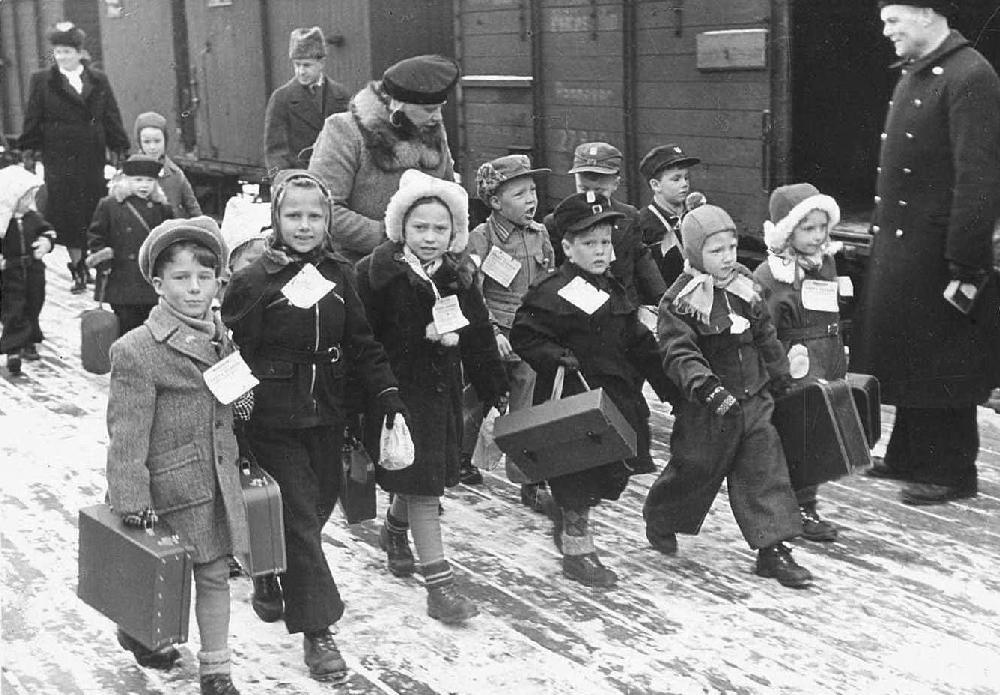
World War II Norway: Aftermath (1945-50)

Figure 1.--The Germans left the Norwegian economy in ruins. Conditions were very diffiult after the War and improved only slowly. Food in particular was in short supply. Here we see Norwegian children after the War being sent to Sweden where they can get some good food and medical care. We do not have the caption, but it was not during the German occupation as the Germans did not allow Norwegians to leave the country. It was also not immediately after liberation (May 1945) as the weather had clearly turned cold. We might guess it was January 1946 because we can't see parents sending the children off until after Christmas. The children are certainly well dressed with what look like new shoes and little suitcases. The box cars in background give the wrong imprssion. It is very unlikely that these children were loaded on to box cars.
|
|
The aftermath of the War in Norwy followed the general direction of that in other Western European countries. After the rough justice of liberation, a juridical process began to identify and judge those who had collaborated with the Germans. This was more difficult than it sounded. Some like Quisling were obviously guolty. But in NAZI occupied countries, it was virtully impossibe not to collaborate to some extent. So the Government had to define just what real collaboration and set standards for punishing the guilty. Formal treason trials were held. The Royal family returned (June 6). Along with the shunning of Norwegian women who collaborated with the Germans, the issue of the Lebensborn children arose. Regugees returned, mostly from Sweden. Food was a serious problem during the occupation. Not only did production fall, but the Norwegins had to feed the German occupation force. Hitler's preoocupation with Norway meant that it was the most heavily garrisoned occupied counry (in terms of soldier per population). The food situation could not be immediately rectified. Some Norwegian children were sent to Sweden for a while where food was more available (figure 1). The economy constricted under German occupation and this included food production. The Norwegian economy collapsed by 45 percent, this was nore than any other country. The economies contracted throuughout the NAZI Gro▀raum, this actually was a factor in Germany's defeat. The economy contracted throughout NAZI dominated Europe, but the decline in Norway was extrodinary. The country's location and the importance of the fishing industry were factors. This was more than any other country occupied by the Germans. [Klemann and Kudryashov] The physical damage was relatvely limited, except in Finnmark--the far north bordering the Soviet Union. Here large areas were destroyed as a result of the scorched earth policy of the retreating Germans. The 'police force' trained in Sweden helped serve as a security force as the police has been compromised by the Germans. The treatment of the German POWs became an issue. The War affected how Norwegians thought of themselves. Norway despite its long history was a new nation. It only became independent from Sweden a few decades before the War (1905). There was little of the patriotic fervor we seein oher European srates. The German occupation in many ways helped define the Norwegian national identity. The Resistance if rather exagereated, provided pst-War Norwegian military and political leaders durable role models. Some historians believe that the shared hardship of the NAZI era provided the kind of national purpose that built needed support for social welfare programs the Norwegian Labour Party governments enacted. It also led to the abandonment of Norway's policy of neutrality inherited from Sweden. Norway became a founding member of NATO (1949). There was a broad political and popular consenus that the country should have a military like Sweden that could resist a future invasion. The major issue as in the rest of Western Europe was economic recovry. Some economists believe it would take Europe a generation to recover. And economic recovery was iniially slow as was the case throughout Europe. The American Marshall Plan appears to have been a turning point. It helped set the German Economic Miracle in motion which in turn impacted the rest of Western Europe. .
CIH -- WW II

Navigate the CIH World War II Section:
[Return to Main World War II Norwegian page ]
[Return to Main World War II German Invasion page ]
[Return to Main World War II country page ]
[Return to Main World War II displaced children page]
[Return to the Main World War II page]
[About Us]
[Aftermath]
[Biographies]
[Campaigns]
[Children]
[Countries]
[Deciding factors]
[Diplomacy]
[Geo-political crisis]
[Economics]
[Home front]
[Intelligence]
[POWs]
[Resistance]
[Race]
[Refugees]
[Technology]
[Totalitarian powers]
[Bibliographies]
[Contributions]
[FAQs]
[Images]
[Links]
[Registration]
[Tools]
[Return to Main World War II page]
[Return to Main war essay page]
[Return to CIH Home page]
Created: 2:54 PM 4/10/2018
Last updated: 2:54 PM 4/10/2018



